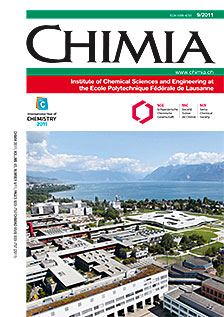Dynamics and Mechanisms of Interfacial Photoinduced Electron Transfer Processes of Third Generation Photovoltaics and Photocatalysis
DOI:
https://doi.org/10.2533/chimia.2011.704Keywords:
Femtochemistry, Molecular/bulk heterojunction, Photocatalysis, Photoinduced electron transfer, Third-generation solar cellsAbstract
Photoinduced electron transfer (PET) across molecular/bulk interfaces has gained attention only recently and is still poorly understood. These interfaces offer an excellent case study, pertinent to a variety of photovoltaic systems, photo- and electrochemistry, molecular electronics, analytical detection, photography, and quantum confinement devices. They play in particular a key role in the emerging fields of third-generation photovoltaic energy converters and artificial photosynthetic systems aimed at the production of solar fuels, creating a need for a better understanding and theoretical treatment of the dynamics and mechanisms of interfacial PET processes. We aim to achieve a fundamental understanding of these phenomena by designing experiments that can be used to test and alter modern theory and computational modeling. One example illustrating recent investigations into the details of the ultrafast processes that form the basis for photoinduced charge separation at a molecular/bulk interface relevant to dye-sensitized solar cells is briefly presented here: Kinetics of interfacial PET and charge recombination processes were measured by fs and ns transient spectroscopy in a heterogeneous donor-bridge-acceptor (D-B-A) system, where D is a RuII(terpyridyl-PO3)(NCS)3 complex, B an oligo-p-phenylene bridge, and A nanocrystalline TiO2. The forward ET reaction was found to be faster than vibrational relaxation of the vibronic excited state of the donor. Instead, the back ET occurred on the ?s time scale and involved fully thermalized species. The D-A distance dependence of the electron transfer rate was studied by varying the number of p-phenylene units contained in the bridge moiety. The remarkably low damping factor ? = 0.16 Å?1 observed for the ultrafast charge injection from the dye excited state into the conduction band of TiO2 is attributed to the coupling of electron tunneling with nonequilibrium vibrations redistributed on the bridge, giving rise to polaronic transport of charges from the donor ligand to the acceptor solid oxide surface.Downloads
Published
2011-09-30
Issue
Section
Scientific Articles
License
Copyright (c) 2011 Swiss Chemical Society

This work is licensed under a Creative Commons Attribution-NonCommercial 4.0 International License.
How to Cite
[1]
Chimia 2011, 65, 704, DOI: 10.2533/chimia.2011.704.







